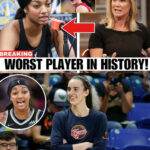Comments made by BBC journalist Katty Kay regarding the contributions of basketball players Caitlyn Clark and Angel Reese to the burgeoning popularity of women’s basketball have ignited a debate about media representation and the valuation of different contributions within the sport. Kay, known for her insightful analysis of American politics and culture, emphasized Clark’s transformative impact, particularly her ability to draw new audiences and her marketability, while appearing to downplay the influence of Angel Reese.

During a recent commentary segment, Kay highlighted Clark’s role in significantly expanding the viewership and overall profile of women’s college basketball. She posited that Clark’s unique appeal transcends traditional sports demographics, attracting a more diverse audience and bolstering the sport’s commercial viability. In drawing a parallel to the historic rivalry between Larry Bird and Magic Johnson in men’s basketball, Kay suggested Clark’s personality and play style are key drivers in the sport’s current growth.
However, it was Kay’s comparative analysis of Clark and Reese that has drawn the most attention. While acknowledging Reese’s contributions to the game, Kay’s commentary implied a hierarchical distinction, suggesting Clark holds a more prominent position in shaping the current landscape of women’s basketball. This perspective has been interpreted by some as overlooking Reese’s own significant achievements and contributions to the sport’s growing popularity.
Critics argue that such pronouncements risk perpetuating biased narratives, particularly considering the racial and cultural dynamics inherent in sports representation. Some argue that Reese’s unapologetic personality and on-court performance have also played a crucial role in attracting attention and challenging established norms within the sport.
Kay’s analysis, delivered from an international perspective, offers a potentially unbiased viewpoint on the Clark-Reese dynamic. However, it also raises broader questions about how media outlets frame discussions surrounding female athletes, and the extent to which factors like marketability and perceived audience appeal influence perceptions of their value. The debate sparked by Kay’s commentary underscores the ongoing complexities in navigating issues of representation, influence, and the evolving landscape of women’s sports. Further analysis and discussions are anticipated as the women’s basketball season progresses.




